
BRDM-2
Encyclopedia
The BRDM-2 is an amphibious armoured patrol car used by Russia and the former Soviet Union
. It was also known under designations BTR-40PB, BTR-40P-2 and GAZ 41-08. This vehicle, like many other Soviet designs, has been exported extensively and is in use in at least 38 countries. It was intended to replace the earlier BRDM-1
with a vehicle that had improved amphibious
capabilities and better armament.
its limitations and drawbacks became obvious. The vehicle had no turret and to operate the armament the gunner had to open a hatch and expose himself to enemy fire. The vehicle wasn't fitted with an NBC protection system, and had no night vision
equipment by default. The vehicle also didn't have any kind of special sights which undermined its usability as a reconnaissance
vehicle. These drawbacks encouraged the design team to create a new vehicle which would suit the modern battlefield.
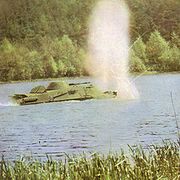



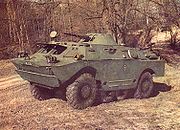
 The BRDM-2 has a crew of four, a driver, a co-driver, a commander, and a gunner. It has two pairs of chain-driven belly wheels lowered by the driver which allow trench crossing just like its predecessor and a centralized tire pressure regulation system which can be used to adjust the tire pressure of all four tires or individual tires while the vehicle is in motion to suit to the ground conditions.
The BRDM-2 has a crew of four, a driver, a co-driver, a commander, and a gunner. It has two pairs of chain-driven belly wheels lowered by the driver which allow trench crossing just like its predecessor and a centralized tire pressure regulation system which can be used to adjust the tire pressure of all four tires or individual tires while the vehicle is in motion to suit to the ground conditions.
Externally, it differs from the BRDM-1 due to its larger, box-like hull. It retains the boat-like bow of the BRDM-1. However, the crew compartment is now further forward and the new GAZ-41 gasoline V-8 engine is in the rear. Thanks to this the engine is much better protected from enemy fire. The engine compartment is also separated from the crew compartment with an armoured barrier. The driver's and commander's stations are in the front of the vehicle, driver is positioned on the left and commander is positioned on the right. Both of them sit in front of bulletproof windscreen which provide them with primary view of the battlefield. When in combat the windscreen can be additionally protected by twin armoured shutters. When the shutters are in their opened position they protect driver and commander from being blinded by the sunlight and ensure that the windscreen won't be blurred by rain or snow. The commander and driver have periscope
s allowing both of them a more detailed view of the surrounding terrain. The commander has 6 TNP-A periscopes (5 in the front and 1 on the side of the vehicle), TPKU-2B day sight and TKN-1 night sight. The driver has 4 TNP-A periscopes (all in the front), one of which can be replaced by TWN-2B night vision
device. The gunner is in the turret during combat but when traveling is seated inside the hull. The crew mounts and dismounts the vehicle via two hatches over driver's and commander's stations. On either side of the hull adjacent to the crew position, there is a firing port. Immediately behind the firing port there are three TNP-A periscopes which protrude from the outside of the hull, giving the crew some vision to the front and rear of the vehicle.
The engine is larger than the BRDM's (it is a 140 hp V-8 instead of a 90 hp 6-cylinder). The BRDM-2 has an IR spotlight and four IR driving lights, as well as an over pressure collective NBC filter system. The IR spotlight is located on top of the commander's periscope. The vehicle also has R-123 radio and an antenna on the right hand side of the hull next to the commander's hatch, for communication. There's also a winch mounted internally at the front hull with a 30 m cable and capacity of 4 tonnes. The winch is intended to used, among others, for self-recovery when stuck in difficult terrain. Also a spare tire can be mounted on top of the turret. This was most often practiced by Polish crews.
Just like its predecessor, BRDM-2 is amphibious. The GAZ-41 gasoline V-8 engine supplies power to the circular water-jet, equipped with a four-bladed propeller at the rear of the vehicle, which is covered with an armoured shutter while on land. This shutter must be removed before entering water. The water-jet allows amphibious travel with a speed of 10 km/h for 17 to 19 hours. A trim board that is stowed under the nose of the hull when traveling and is erected at the front of the hull before entering the water to improve vehicle's stability and displacement in water and prevent the water from flooding the bow of the BRDM-2. While in its traveling position it serves as additional armour.
, a 14.5 mm KPVT
heavy machine gun with a coaxial 7.62 mm PKT general-purpose machine gun as a secondary weapon both in a small conical BPU-1 turret mounted on the hull in a central position above the belly wheels.
The 14.5 mm KPVT heavy machine gun has a practical rate of fire of 150 rounds per minute and cyclic rate of fire of 600 rounds per minute. It has an effective range during day time operations of 2,000 m. It can penetrate 20 mm of armour at range of 1000 m and 30 mm of armour at range of 500 m. It can fire at air targets and has a tactical anti-aircraft range of 1,400 m. It uses the 14.5 mm API-T, 14.5 mm I-T, 14.5 mm HE-T, 14.5 mm and MDZ type ammunition.
The 7.62 mm PKT coaxial general-purpose machine gun has an effective range during day time operations of 1,000 m while the vehicle is stationary and from 400 m to 500 m while the vehicle is on the move. It is fired in 2 to 10 round bursts and has a practical rate of fire of 250 rounds per minute and cyclic rate of fire of 650 rounds per minute. The gunner is using the PP-61AM sight during day time operations which has a field of view of 23 degrees and 2,6 magnification.
The BPU-1 turret is unusual because it has no top hatch opening. Contrary to the popular belief the BPU-1 turret was originally designed for BRDM-2. The turret was later used in Soviet BTR-60PB, Polish SKOT-2A and Czechoslovak OT-64A. The turret allows the armament to be elevated between −5 and +30 degrees. On the left-hand side of the turret there is an air inlet on the hull top. There are also two air-inlet louvers in the forward of the engine compartment's roof and four smaller air-inlet louvers to the rear. Both sides have centrally placed vision blocks.
The armor on the vehicle which is composed of welded steel, protects it fully against small arms
fire and small shell fragments but doesn't protect it against big artillery fragments and a .50-calibre machine gun fire which can penetrate BRDM-2 maximum armor of 14 millimeters. The BRDM-2-series tires are not protected by armour. They are particularly vulnerable to puncture from fire of all kinds.
There are three different production lots that have different cooling vents on the engine deck. Late production version has mushroom-type vents. It also has slightly modified turret and can elevate its armament to +60 degrees. Final production BRDM-2's have additional turret periscopes and a TNA-2 navigation apparatus.
BRDM-2 has unique flaw of its own. Because the only way in and out of the vehicle is via the front hatches, leaving the vehicle while in combat is almost impossible because the exiting crew members would instantly enter the line of fire of the enemy and its own vehicle as hatches are positioned directly in front of the turret. This shortcoming was addressed in Polish BRDM-2M-96 modernization and its successors, BRDM-2M-96i, BRDM-2M-96ik "Szakal", BRDM-2M-96ik "Szakal Plus", BRDM-2M-97 "Żbik-B", BRDM-2M-97C "Żbik-P" and BRDM-2M-98 "Żbik-A" which have side hatches. This was also done in Czech LOT-B and OKV-P as well as Ukrainian BRDM-2SMD. Polish BRDM-2M-97 "Żbik-B", BRDM-2M-97C "Żbik-P" and BRDM-2M-98 "Żbik-A" also have hatch on the top of the turret giving the crew another way out.
BRDM-2's predecessor, BRDM-1 didn't have that issue as the BRDM-1 obr. 1957 had no roof and later models had rear hatch that allow the crew to exit the vehicle from behind. The fact that BRDM-2 is missing such a hatch is a consequence of putting the engine in the rear unlike in BRDM-1 where engine is in the front.
The BRDM-2 is sometimes confused with the Hungarian D-442 FUG and D-944 PSzH amphibious scout cars which also have rear-mounted engines but what distinguishes them from BRDM-2 is the fact that they have twin waterjets unlike the BRDM-2 which has a single triangular water jet.
in 1962. It was first publicly shown in 1966. It has replaced the BRDM-1 in the Soviet and Warsaw Pact
armies. The production started in 1962 and went on until 1989 with 7,200 vehicles produced (mostly for export). The BTR-60PB is replacing the BRDM-2 in divisional reconnaissance
battalions .
The BRDM-2 became famous for being a vehicle selected to pull Andropov's
coffin
during the funeral ceremony in the Red Square
.
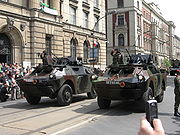 Poland bought 450 BRDM-2 armoured scout cars, 418 9P133 "Malyutka" and 9P148 "Konkurs" tank destroyers and 32 BRDM-2RS NBC reconnaissance vehicles in 1965. Later Poland also obtained 9P31 Surface-to-air missile
Poland bought 450 BRDM-2 armoured scout cars, 418 9P133 "Malyutka" and 9P148 "Konkurs" tank destroyers and 32 BRDM-2RS NBC reconnaissance vehicles in 1965. Later Poland also obtained 9P31 Surface-to-air missile
launchers. In 2004 Polish Army operated 600 BRDM-2 armoured scout cars and vehicles based on it. As of now Polish Army operates 200 BRDM-2s, 120 BRDM-2s modernized to BRDM-2M-96, BRDM-2M-96i, BRDM-2M-97 "Żbik-B" and BRDM-2M-98 "Żbik-A" level, 12 BRDM-2s modernized to BRDM-2M-96ik "Szakal" level, 100 9P133 "Malyutka" and 18 9P148 "Konkurs" tank destroyers, a dozen of BRDM-2RS NBC reconnaissance vehicles, an unknown number of 9K31 Strela-1 self-propelled surface-to-air missile launchers as well as BRDM-2 R-1A and BRDM-2 R-5 command vehicles. Also one BRDM-2 was modernized to BRDM-2M-96ik "Szakal Plus" level. All modernizations, conversions and serious repairs of Polish BRDM-2 are done by WZM in Siemianowice Śląskie
. Modernized BRDM-2 armoured scout cars will serve with the Polish Army for at least a couple of years. The 9P133 "Malyutka" and 9P148 "Konkurs" tank destroyers which are the basic equipment of anti-tank subunits of motorized brigades, are considered obsolete and therefore are to be replaced with ATGM launchers based on lighter vehicles like the HMMWV or heavier vehicles like KTO Ryś APC or KTO Rosomak
AMV.
For MSPO 2002 two Polish BRDM-2M-96i were converted into a fire unit and command vehicle with a radar of the German Rheinmetall Defence Electronics ASRAD-R
missile air defense system. The system won the "Defender" award at that year's event.
Polish BRDM-2M-96ik "Szakal" was shown at the Land Combat Expo 2004.
Two BRDM-2M-97 "Żbik-B" armoured scout cars took part in a military parade in Kraków on 17 May 2008. Seven BRDM-2M-97 "Żbik-B" armoured scout cars and six 9P148 "Konkurs" tank destroyers took part in a military parade in Warsaw on the Polish Army Day, 15 August 2008.
BRDM-2, BRDM-2M-96 and BRDM-2M-96i armoured cars were used by Polish units of SFOR
. Polish KFOR units also use BRDM-2M-96 armoured scout cars and BRDM-2RS NBC reconnaissance vehicles. Polish Forces in Iraq operated 12 BRDM-2M-96ik "Szakal" and 14 BRDM-2M-97 "Żbik-B". 10 BRDM-2M-96ik were used by Polish forces of ISAF
. However they are now together with 12 vehicles used in Iraq, back in Poland.
The BRDM-2 participated in several wars. It took part in Soviet War in Afghanistan
. Those vehicles as well as derelict ones restored back up to working state are now used Afghan National Army
. BRDM-2 armoured scout cars also were used during either Six-Day War
(1967), War of Attrition
(1968–1970) or Yom Kippur War
(1973) by either Egypt or Syria. During one of these conflicts Israel managed to capture a number of BRDM-2 armoured cars and vehicles based on it (like BRDM-2UM command vehicle and 9P122 "Malyutka" tank destroyer). The BRDM-2 has also seen service with Iraqi Army during First Persian Gulf War and 2003 invasion of Iraq.
BRDM-2 armoured scout cars were used during Ten-Day War
and first operations in Croatia during Croatian War of Independence
by Yugoslav People's Army
(JNA). The BRDM-2 was also used by the Yugoslav Army (VJ) against the KLA
during the Kosovo war
. BRDM-2 armoured scout cars are used by Polish, Ukrainian and Russian units of the Kosovo Force.
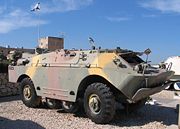
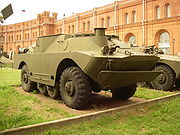

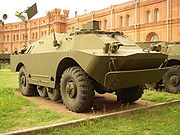
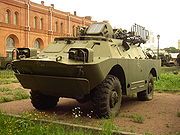
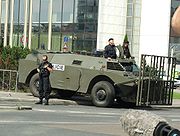
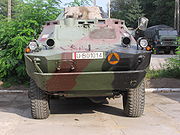
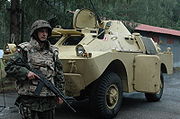
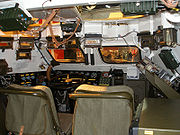
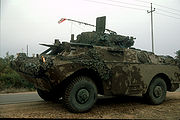
_unloads_bulgarian_vehicle.jpg) – – mostly captured vehicles from the war with the Soviet Union, some were abandoned vehicles left behind by retreating Soviets and some were derelict vehicles left by the Soviets all over Afghanistan and brought back to working condition. – 60 BRDM-2 and 64 9P122 "Malyutka". – 50 – 120 – – 24+ – 29 – – 200 – – 13 delivered by Belarus between 2002 and 2003. – 100 BRDM-2 used for the special forces and 50 modernized with a 120mm mortar – BRDM-2RKh and 9P31 – – 300 BRDM-2 and BRDM-2UM – – 7 – 4 delivered by Ukraine in 1998. – – – – New Iraqi Army uses a number of BRDM-2 armed with ZPU-2 twin 14.5 mm KPV antiaircraft heavy machine guns (See Iraq section for details). Ukraine delivered 13 BRDM-2 armoured scout cars to the New Iraqi Army in 2006. Iraqi Regular Army operated 1,300 BRDM-1 and BRDM-2 armoured scout cars and vehicles based on them. – – 2 – – 10 in service as of 2006. 21 delivered by Poland between 1993 and 1995 (10 in 1993 and 11 in 1995). – 10 – – – BRDM-2 and BRDM-2Rkh – 45 BRDM-2 delivered by Russia to the Palestinian Authority Police in 1995, later seized by Hamas
– – mostly captured vehicles from the war with the Soviet Union, some were abandoned vehicles left behind by retreating Soviets and some were derelict vehicles left by the Soviets all over Afghanistan and brought back to working condition. – 60 BRDM-2 and 64 9P122 "Malyutka". – 50 – 120 – – 24+ – 29 – – 200 – – 13 delivered by Belarus between 2002 and 2003. – 100 BRDM-2 used for the special forces and 50 modernized with a 120mm mortar – BRDM-2RKh and 9P31 – – 300 BRDM-2 and BRDM-2UM – – 7 – 4 delivered by Ukraine in 1998. – – – – New Iraqi Army uses a number of BRDM-2 armed with ZPU-2 twin 14.5 mm KPV antiaircraft heavy machine guns (See Iraq section for details). Ukraine delivered 13 BRDM-2 armoured scout cars to the New Iraqi Army in 2006. Iraqi Regular Army operated 1,300 BRDM-1 and BRDM-2 armoured scout cars and vehicles based on them. – – 2 – – 10 in service as of 2006. 21 delivered by Poland between 1993 and 1995 (10 in 1993 and 11 in 1995). – 10 – – – BRDM-2 and BRDM-2Rkh – 45 BRDM-2 delivered by Russia to the Palestinian Authority Police in 1995, later seized by Hamas
following the Battle of Gaza
in June 2007. – Late production BDRM-2 model and 9P133 ATGM launcher. – 200 BRDM-2s, 120 BRDM-2s modernized to BRDM-2M-96, BRDM-2M-96i, BRDM-2M-97 "Żbik-B" and BRDM-2M-98 "Żbik-A" level, 22 BRDM-2s modernized to BRDM-2M-96ik "Szakal" level, 100 9P133 "Malyutka" and 18 9P148 "Konkurs" tank destroyers, a dozen of BRDM-2RS NBC reconnaissance vehicles, an unknown number of 9K31 Strela-1 self-propelled surface-to-air missile launchers as well as BRDM-2 R-1A and BRDM-2 R-5 command vehicles. – Late production BDRM-2 model and 9P31 SAM launcher.
– 138 (12 9P122 "Malyutka", 78 9P133 "Malyutka" and 48 9P148 Konkurs) – 2,000 – 28 – – 5 late production BDRM-2s. Command company of 44th Armored-mechanized Battalion "Wolfs" operates BRDM-2 vehicles. – 60 delivered by Belarus between 2003 and 2004 (39 in 2003 and 21 in 2004). – 950 – 30 – Delivered 13 BRDM-2 armoured scout cars to the New Iraqi Army in 2006. – 200 – –
Soviet Union
The Soviet Union , officially the Union of Soviet Socialist Republics , was a constitutionally socialist state that existed in Eurasia between 1922 and 1991....
. It was also known under designations BTR-40PB, BTR-40P-2 and GAZ 41-08. This vehicle, like many other Soviet designs, has been exported extensively and is in use in at least 38 countries. It was intended to replace the earlier BRDM-1
BRDM-1
The BRDM-1 was an amphibious armored scout car used by Russia and the former Soviet Union...
with a vehicle that had improved amphibious
Amphibious vehicle
An amphibious vehicle , is a vehicle or craft, that is a means of transport, viable on land as well as on water – just like an amphibian....
capabilities and better armament.
History
After few years of exploitation of BRDM-1 by the Soviet ArmySoviet Army
The Soviet Army is the name given to the main part of the Armed Forces of the Soviet Union between 1946 and 1992. Previously, it had been known as the Red Army. Informally, Армия referred to all the MOD armed forces, except, in some cases, the Soviet Navy.This article covers the Soviet Ground...
its limitations and drawbacks became obvious. The vehicle had no turret and to operate the armament the gunner had to open a hatch and expose himself to enemy fire. The vehicle wasn't fitted with an NBC protection system, and had no night vision
Night vision
Night vision is the ability to see in low light conditions. Whether by biological or technological means, night vision is made possible by a combination of two approaches: sufficient spectral range, and sufficient intensity range...
equipment by default. The vehicle also didn't have any kind of special sights which undermined its usability as a reconnaissance
Reconnaissance
Reconnaissance is the military term for exploring beyond the area occupied by friendly forces to gain information about enemy forces or features of the environment....
vehicle. These drawbacks encouraged the design team to create a new vehicle which would suit the modern battlefield.
Construction






Externally, it differs from the BRDM-1 due to its larger, box-like hull. It retains the boat-like bow of the BRDM-1. However, the crew compartment is now further forward and the new GAZ-41 gasoline V-8 engine is in the rear. Thanks to this the engine is much better protected from enemy fire. The engine compartment is also separated from the crew compartment with an armoured barrier. The driver's and commander's stations are in the front of the vehicle, driver is positioned on the left and commander is positioned on the right. Both of them sit in front of bulletproof windscreen which provide them with primary view of the battlefield. When in combat the windscreen can be additionally protected by twin armoured shutters. When the shutters are in their opened position they protect driver and commander from being blinded by the sunlight and ensure that the windscreen won't be blurred by rain or snow. The commander and driver have periscope
Periscope
A periscope is an instrument for observation from a concealed position. In its simplest form it consists of a tube with mirrors at each end set parallel to each other at a 45-degree angle....
s allowing both of them a more detailed view of the surrounding terrain. The commander has 6 TNP-A periscopes (5 in the front and 1 on the side of the vehicle), TPKU-2B day sight and TKN-1 night sight. The driver has 4 TNP-A periscopes (all in the front), one of which can be replaced by TWN-2B night vision
Night vision
Night vision is the ability to see in low light conditions. Whether by biological or technological means, night vision is made possible by a combination of two approaches: sufficient spectral range, and sufficient intensity range...
device. The gunner is in the turret during combat but when traveling is seated inside the hull. The crew mounts and dismounts the vehicle via two hatches over driver's and commander's stations. On either side of the hull adjacent to the crew position, there is a firing port. Immediately behind the firing port there are three TNP-A periscopes which protrude from the outside of the hull, giving the crew some vision to the front and rear of the vehicle.
The engine is larger than the BRDM's (it is a 140 hp V-8 instead of a 90 hp 6-cylinder). The BRDM-2 has an IR spotlight and four IR driving lights, as well as an over pressure collective NBC filter system. The IR spotlight is located on top of the commander's periscope. The vehicle also has R-123 radio and an antenna on the right hand side of the hull next to the commander's hatch, for communication. There's also a winch mounted internally at the front hull with a 30 m cable and capacity of 4 tonnes. The winch is intended to used, among others, for self-recovery when stuck in difficult terrain. Also a spare tire can be mounted on top of the turret. This was most often practiced by Polish crews.
Just like its predecessor, BRDM-2 is amphibious. The GAZ-41 gasoline V-8 engine supplies power to the circular water-jet, equipped with a four-bladed propeller at the rear of the vehicle, which is covered with an armoured shutter while on land. This shutter must be removed before entering water. The water-jet allows amphibious travel with a speed of 10 km/h for 17 to 19 hours. A trim board that is stowed under the nose of the hull when traveling and is erected at the front of the hull before entering the water to improve vehicle's stability and displacement in water and prevent the water from flooding the bow of the BRDM-2. While in its traveling position it serves as additional armour.
Armament
The armament is the same as the BTR-60PB armoured personnel carrierArmoured personnel carrier
An armoured personnel carrier is an armoured fighting vehicle designed to transport infantry to the battlefield.APCs are usually armed with only a machine gun although variants carry recoilless rifles, anti-tank guided missiles , or mortars...
, a 14.5 mm KPVT
KPV heavy machine gun
The KPV-14.5 heavy machine gun is a Soviet designed 14.5x114mm-caliber heavy machine gun, which first entered service as an infantry weapon in 1949. In the 1960s the infantry version was taken out of production because it was too big and heavy...
heavy machine gun with a coaxial 7.62 mm PKT general-purpose machine gun as a secondary weapon both in a small conical BPU-1 turret mounted on the hull in a central position above the belly wheels.
The 14.5 mm KPVT heavy machine gun has a practical rate of fire of 150 rounds per minute and cyclic rate of fire of 600 rounds per minute. It has an effective range during day time operations of 2,000 m. It can penetrate 20 mm of armour at range of 1000 m and 30 mm of armour at range of 500 m. It can fire at air targets and has a tactical anti-aircraft range of 1,400 m. It uses the 14.5 mm API-T, 14.5 mm I-T, 14.5 mm HE-T, 14.5 mm and MDZ type ammunition.
The 7.62 mm PKT coaxial general-purpose machine gun has an effective range during day time operations of 1,000 m while the vehicle is stationary and from 400 m to 500 m while the vehicle is on the move. It is fired in 2 to 10 round bursts and has a practical rate of fire of 250 rounds per minute and cyclic rate of fire of 650 rounds per minute. The gunner is using the PP-61AM sight during day time operations which has a field of view of 23 degrees and 2,6 magnification.
The BPU-1 turret is unusual because it has no top hatch opening. Contrary to the popular belief the BPU-1 turret was originally designed for BRDM-2. The turret was later used in Soviet BTR-60PB, Polish SKOT-2A and Czechoslovak OT-64A. The turret allows the armament to be elevated between −5 and +30 degrees. On the left-hand side of the turret there is an air inlet on the hull top. There are also two air-inlet louvers in the forward of the engine compartment's roof and four smaller air-inlet louvers to the rear. Both sides have centrally placed vision blocks.
The armor on the vehicle which is composed of welded steel, protects it fully against small arms
Small arms
Small arms is a term of art used by armed forces to denote infantry weapons an individual soldier may carry. The description is usually limited to revolvers, pistols, submachine guns, carbines, assault rifles, battle rifles, multiple barrel firearms, sniper rifles, squad automatic weapons, light...
fire and small shell fragments but doesn't protect it against big artillery fragments and a .50-calibre machine gun fire which can penetrate BRDM-2 maximum armor of 14 millimeters. The BRDM-2-series tires are not protected by armour. They are particularly vulnerable to puncture from fire of all kinds.
There are three different production lots that have different cooling vents on the engine deck. Late production version has mushroom-type vents. It also has slightly modified turret and can elevate its armament to +60 degrees. Final production BRDM-2's have additional turret periscopes and a TNA-2 navigation apparatus.
Variants
BRDM-2 has flaws that are also apparent in other Soviet vehicles. These include the low rate of ergonomy and protection of the crew and large fuel consumption. The low ergonomy level was addressed in Polish BRDM-2M-96 modernization and its successors, BRDM-2M-96i, BRDM-2M-96ik "Szakal", BRDM-2M-96ik "Szakal Plus", BRDM-2M-97 "Żbik-B", BRDM-2M-97C "Żbik-P" and BRDM-2M-98 "Żbik-A" which have belly wheels removed which gives more space for the crew or space for two soldiers. This was also carried out in Morozov's BRDM-2SMD.BRDM-2 has unique flaw of its own. Because the only way in and out of the vehicle is via the front hatches, leaving the vehicle while in combat is almost impossible because the exiting crew members would instantly enter the line of fire of the enemy and its own vehicle as hatches are positioned directly in front of the turret. This shortcoming was addressed in Polish BRDM-2M-96 modernization and its successors, BRDM-2M-96i, BRDM-2M-96ik "Szakal", BRDM-2M-96ik "Szakal Plus", BRDM-2M-97 "Żbik-B", BRDM-2M-97C "Żbik-P" and BRDM-2M-98 "Żbik-A" which have side hatches. This was also done in Czech LOT-B and OKV-P as well as Ukrainian BRDM-2SMD. Polish BRDM-2M-97 "Żbik-B", BRDM-2M-97C "Żbik-P" and BRDM-2M-98 "Żbik-A" also have hatch on the top of the turret giving the crew another way out.
BRDM-2's predecessor, BRDM-1 didn't have that issue as the BRDM-1 obr. 1957 had no roof and later models had rear hatch that allow the crew to exit the vehicle from behind. The fact that BRDM-2 is missing such a hatch is a consequence of putting the engine in the rear unlike in BRDM-1 where engine is in the front.
The BRDM-2 is sometimes confused with the Hungarian D-442 FUG and D-944 PSzH amphibious scout cars which also have rear-mounted engines but what distinguishes them from BRDM-2 is the fact that they have twin waterjets unlike the BRDM-2 which has a single triangular water jet.
Soviet Union and Russia
The BRDM-2 entered service with Soviet ArmySoviet Army
The Soviet Army is the name given to the main part of the Armed Forces of the Soviet Union between 1946 and 1992. Previously, it had been known as the Red Army. Informally, Армия referred to all the MOD armed forces, except, in some cases, the Soviet Navy.This article covers the Soviet Ground...
in 1962. It was first publicly shown in 1966. It has replaced the BRDM-1 in the Soviet and Warsaw Pact
Warsaw Pact
The Warsaw Treaty Organization of Friendship, Cooperation, and Mutual Assistance , or more commonly referred to as the Warsaw Pact, was a mutual defense treaty subscribed to by eight communist states in Eastern Europe...
armies. The production started in 1962 and went on until 1989 with 7,200 vehicles produced (mostly for export). The BTR-60PB is replacing the BRDM-2 in divisional reconnaissance
Reconnaissance
Reconnaissance is the military term for exploring beyond the area occupied by friendly forces to gain information about enemy forces or features of the environment....
battalions .
The BRDM-2 became famous for being a vehicle selected to pull Andropov's
Yuri Andropov
Yuri Vladimirovich Andropov was a Soviet politician and the General Secretary of the Communist Party of the Soviet Union from 12 November 1982 until his death fifteen months later.-Early life:...
coffin
Coffin
A coffin is a funerary box used in the display and containment of dead people – either for burial or cremation.Contemporary North American English makes a distinction between "coffin", which is generally understood to denote a funerary box having six sides in plan view, and "casket", which...
during the funeral ceremony in the Red Square
Red Square
Red Square is a city square in Moscow, Russia. The square separates the Kremlin, the former royal citadel and currently the official residence of the President of Russia, from a historic merchant quarter known as Kitai-gorod...
.
Poland

Surface-to-air missile
A surface-to-air missile or ground-to-air missile is a missile designed to be launched from the ground to destroy aircraft or other missiles...
launchers. In 2004 Polish Army operated 600 BRDM-2 armoured scout cars and vehicles based on it. As of now Polish Army operates 200 BRDM-2s, 120 BRDM-2s modernized to BRDM-2M-96, BRDM-2M-96i, BRDM-2M-97 "Żbik-B" and BRDM-2M-98 "Żbik-A" level, 12 BRDM-2s modernized to BRDM-2M-96ik "Szakal" level, 100 9P133 "Malyutka" and 18 9P148 "Konkurs" tank destroyers, a dozen of BRDM-2RS NBC reconnaissance vehicles, an unknown number of 9K31 Strela-1 self-propelled surface-to-air missile launchers as well as BRDM-2 R-1A and BRDM-2 R-5 command vehicles. Also one BRDM-2 was modernized to BRDM-2M-96ik "Szakal Plus" level. All modernizations, conversions and serious repairs of Polish BRDM-2 are done by WZM in Siemianowice Śląskie
Siemianowice Slaskie
Siemianowice Śląskie aka Siemianowice ; is a city in Upper Silesia in southern Poland, near Katowice. The central district of the Upper Silesian Metropolitan Union - metropolis with the population of 2 millions...
. Modernized BRDM-2 armoured scout cars will serve with the Polish Army for at least a couple of years. The 9P133 "Malyutka" and 9P148 "Konkurs" tank destroyers which are the basic equipment of anti-tank subunits of motorized brigades, are considered obsolete and therefore are to be replaced with ATGM launchers based on lighter vehicles like the HMMWV or heavier vehicles like KTO Ryś APC or KTO Rosomak
KTO Rosomak
The KTO Rosomak is 8x8 multi-role military vehicle produced by...
AMV.
For MSPO 2002 two Polish BRDM-2M-96i were converted into a fire unit and command vehicle with a radar of the German Rheinmetall Defence Electronics ASRAD-R
ASRAD-R
ASRAD-R is a German designed vehicle-mounted short-range surface-to-air missile system, utilizing the Swedish BOLIDE laser-guided SAM missile, and the Ericsson Microwave System HARD 3D radar....
missile air defense system. The system won the "Defender" award at that year's event.
Polish BRDM-2M-96ik "Szakal" was shown at the Land Combat Expo 2004.
Two BRDM-2M-97 "Żbik-B" armoured scout cars took part in a military parade in Kraków on 17 May 2008. Seven BRDM-2M-97 "Żbik-B" armoured scout cars and six 9P148 "Konkurs" tank destroyers took part in a military parade in Warsaw on the Polish Army Day, 15 August 2008.
BRDM-2, BRDM-2M-96 and BRDM-2M-96i armoured cars were used by Polish units of SFOR
SFOR
The Stabilisation Force was a NATO-led multinational peacekeeping force in Bosnia and Herzegovina which was tasked with upholding the Dayton Agreement. It replaced the previous force IFOR...
. Polish KFOR units also use BRDM-2M-96 armoured scout cars and BRDM-2RS NBC reconnaissance vehicles. Polish Forces in Iraq operated 12 BRDM-2M-96ik "Szakal" and 14 BRDM-2M-97 "Żbik-B". 10 BRDM-2M-96ik were used by Polish forces of ISAF
International Security Assistance Force
The International Security Assistance Force is a NATO-led security mission in Afghanistan established by the United Nations Security Council on 20 December 2001 by Resolution 1386 as envisaged by the Bonn Agreement...
. However they are now together with 12 vehicles used in Iraq, back in Poland.
Estonia
Around 10 BRDM-2s were taken over from the Russian Army in the early 1990s. They were mostly used during infantry training for posing as the enemy armour. Also the Estonian police used a specially modified BRDM-2 (See the Estonia section in the Variants section). All BRDM-2s are now withdrawn from both the military and police service.Other operators
Like all Soviet equipment, the BRDM-2 was also sold to many Arab and African countries. It is used by 38 armies. The BRDM-2 enjoyed its popularity on export market by being cheap, easy to operate and reliable. These factors made the BRDM-2 a more popular export reconnaissance vehicle than the BRM-1K, which was much more expensive and complicated to operate.The BRDM-2 participated in several wars. It took part in Soviet War in Afghanistan
Soviet war in Afghanistan
The Soviet war in Afghanistan was a nine-year conflict involving the Soviet Union, supporting the Marxist-Leninist government of the Democratic Republic of Afghanistan against the Afghan Mujahideen and foreign "Arab–Afghan" volunteers...
. Those vehicles as well as derelict ones restored back up to working state are now used Afghan National Army
Afghan National Army
The Afghan National Army is a service branch of the military of Afghanistan, which is currently trained by the coalition forces to ultimately take the role in land-based military operations in Afghanistan. , the Afghan National Army is divided into seven regional Corps. The strength of the Afghan...
. BRDM-2 armoured scout cars also were used during either Six-Day War
Six-Day War
The Six-Day War , also known as the June War, 1967 Arab-Israeli War, or Third Arab-Israeli War, was fought between June 5 and 10, 1967, by Israel and the neighboring states of Egypt , Jordan, and Syria...
(1967), War of Attrition
War of Attrition
The international community and both countries attempted to find a diplomatic solution to the conflict. The Jarring Mission of the United Nations was supposed to ensure that the terms of UN Security Council Resolution 242 would be observed, but by late 1970 it was clear that this mission had been...
(1968–1970) or Yom Kippur War
Yom Kippur War
The Yom Kippur War, Ramadan War or October War , also known as the 1973 Arab-Israeli War and the Fourth Arab-Israeli War, was fought from October 6 to 25, 1973, between Israel and a coalition of Arab states led by Egypt and Syria...
(1973) by either Egypt or Syria. During one of these conflicts Israel managed to capture a number of BRDM-2 armoured cars and vehicles based on it (like BRDM-2UM command vehicle and 9P122 "Malyutka" tank destroyer). The BRDM-2 has also seen service with Iraqi Army during First Persian Gulf War and 2003 invasion of Iraq.
BRDM-2 armoured scout cars were used during Ten-Day War
Ten-Day War
The Ten-Day War or the Slovenian Independence War was a military conflict between the Slovenian Territorial Defence and the Yugoslav People's Army in 1991 following Slovenia's declaration of independence.-Background:...
and first operations in Croatia during Croatian War of Independence
Croatian War of Independence
The Croatian War of Independence was fought from 1991 to 1995 between forces loyal to the government of Croatia—which had declared independence from the Socialist Federal Republic of Yugoslavia —and the Serb-controlled Yugoslav People's Army and local Serb forces, with the JNA ending its combat...
by Yugoslav People's Army
Yugoslav People's Army
The Yugoslav People's Army , also referred to as the Yugoslav National Army , was the military of the Socialist Federal Republic of Yugoslavia.-Origins:The origins of the JNA can...
(JNA). The BRDM-2 was also used by the Yugoslav Army (VJ) against the KLA
Kosovo Liberation Army
The Kosovo Liberation Army or KLA was a Kosovar Albanian paramilitary organization which sought the separation of Kosovo from Federal Republic of Yugoslavia in the 1990s....
during the Kosovo war
Kosovo War
The term Kosovo War or Kosovo conflict was two sequential, and at times parallel, armed conflicts in Kosovo province, then part of FR Yugoslav Republic of Serbia; from early 1998 to 1999, there was an armed conflict initiated by the ethnic Albanian "Kosovo Liberation Army" , who sought independence...
. BRDM-2 armoured scout cars are used by Polish, Ukrainian and Russian units of the Kosovo Force.
Soviet Union





- BRDM-2 – basic reconnaissance vehicle, distinguished by its turret, which is the same as that mounted on the BTR-60PB. The conical turret, which mounts two machine guns (14.5 mm and 7.62 mm), is unusual in that it has no top hatch opening. This model carries a crew of four: the commander, the gunner, the driver, and the co-gunner. It also has a land navigation system that gives co-ordinate readings. Late Production version had mushroom-type vents on top of engine compartment. Final production model had two additional turret periscopes, one on top of turret and the other one on the left hand side of the turret and a TNA-2 navigation apparatus. It was also known under designations BTR-40PB, BTR-40P-2 and GAZ 41-08.
- BRDM-2 without the 14.5 mm KPVT heavy machine gun.
- BRDM-2RKh (khimicheskaya razvedivatel’naya mashina) – radiological-chemical reconnaissance vehicle with two KZO-2 rectangular dispensers for emplacing warning poles and flags around contaminated areas. The pole/flag dispensers are located on the rear corners of the vehicle's hull. The dispensers are normally covered with canvas and when required are positioned vertically over the rear of the vehicle. The specialized equipment consist of an automatioc gas detector GSA-12, a dosimeter DP-5V, a röntgenmeter DP-3B, decontamination apparatus DK-4K and semi-automatic detection devices PPKhR and VPKhR. The vehicle retains the original armament. The regimental chemical defence platoon and the divisional-level chemical defence company use it, as the does divisional reconnaissance battalion. It was also known under designations BRDM-2RKhA, BTR-40P-2RKh and BTR-40PB-RKh.
- BRDM-2RKhb – improved model that can also be used for biological reconnaissance, thanks to specialised equipment including the DP-5B röntgenmeter and biological aerosol detector ASP. BRDM-2RKhb doesn't have the firing ports. This model has twin 7.62 mm PKT general-purpose machine guns instead of the 14.5 mm KPVT heavy machine gun and 7.62 mm PKT coaxial general-purpose machine gun and usually carries only one KZO-2 dispenser. It was also known under designation BRDM-2RKhB.
- BRDM-2UM (mashina upravleniya) – command vehicle without turret; however, it carries a 1 kW generator and extra radios (two R-123 and an R-107, or according to other sources one R-105M, one R-108M and one R-130M). On either side of the upper hull there is a big antenna base. Contrary to general Western belief, this is actually a very rare vehicle primarily built for export.
- 9P122 "Malyutka" – ATGM launcher vehicle with 6x9M14M "Malyutka-M"AT-3 SaggerThe 9K11 Malyutka is a Manual Command to Line-of-Sight wire-guided anti-tank guided missile developed in the Soviet Union. It was the first man-portable anti-tank guided missile of the Soviet Union and is probably the most widely produced ATGM of all time—with Soviet production peaking at...
(AT-3B Sagger B) on an elevatable mount with overhead cover. A total of 14 missiles are carried on board. This model is found in regimental and divisional anti-tank units of MRDs, the anti-tank regiments of combined arms armies (CAA), and in the anti-tank regiment or brigade in the artillery division of a front. It has a crew of 2.- 9P133 "Malyutka" – this is an improved model with bigger sight 9S446 instead of the original 9S414. The 9P133 can launch the more capable 9M14P "Malyutka-P"AT-3 SaggerThe 9K11 Malyutka is a Manual Command to Line-of-Sight wire-guided anti-tank guided missile developed in the Soviet Union. It was the first man-portable anti-tank guided missile of the Soviet Union and is probably the most widely produced ATGM of all time—with Soviet production peaking at...
(AT-3C Sagger C) and 9M14P1 missiles of which it carries from 16 to 18. It uses SACLOS guidance system. The vehicle also has additional windscreen on the front between the drivers windscreen and the sight mounting.
- 9P133 "Malyutka" – this is an improved model with bigger sight 9S446 instead of the original 9S414. The 9P133 can launch the more capable 9M14P "Malyutka-P"
- 9P124 – ATGM carrier vehicle with 4 radio-guided 9M17M "Skorpion-M"AT-2 SwatterThe AT-2 Swatter is the NATO reporting name for the 3M11 Fleyta MCLOS radio command Anti-tank missile of the Soviet Union.-Development:...
(AT-2B Swatter B) AT missiles on an elevatable mount with overhead cover. In the hull are four more missiles. It uses MCLOS guidance system. The 9P124 has a crew of 2. It was also known under designation BRDM-3.- 9P137 "Flejta" – improved model that uses the 9K8 "Flejta" system which allows usage of 9M19P ATGMs with SACLOS instead of MCLOS guidance. The launcher has 5 rails instead of 4.
- 9P148 "Konkurs" – ATGM launcher vehicle with 5 wire-guided 9M113 "Konkurs"AT-5 SpandrelThe 9M113 Konkurs SACLOS wire-guided Anti-tank missile of the Soviet Union. "9M113" is the GRAU designation of the missile. Its NATO reporting name is AT-5 Spandrel.-Development:...
(AT-5 Spandrel). The AT-5 launcher can also fire the 9M111 "Fagot"AT-4 SpigotThe 9K111 Fagot is a SACLOS wire-guided anti-tank missile system of the Soviet Union. "9M111" is the GRAU designation of the missile. Its NATO reporting name is AT-4 Spigot.-Development:...
(AT-4 Spigot) missile. The early production model of 9P148 could only fire 9M113 "Konkurs". The crew reloads the launcher through a small hatch located behind it. The gunner controls the missiles through a sight mounted on the front right of the vehicle. The 9P148 can carry a total of 10 9M111 and 10 9M113 or 14 9M113. From 1996 some Russian 9P148 were fitted with an improved 1PN66 day/night thermal sight. In the West, it was also known under the incorrect designation BRDM-3.- 9P148 "Konkurs" with the whip antenna mount fitted to the right hand side pistol port. This is the standard production model.
- 9P31 – launcher vehicle for the 9M31 surface-to-air missile, belonging to the 9K31 Strela-1 (NATO: SA-9 "Gaskin") vehicle-mounted low-altitude SAM system. The SAM launching system with quadruple canister replaces the machine gun turret on top of the vehicle, it is capable of 360 degrees traverse and limited elevation. It is lowered for travel. The vehicle doesn't have the belly wheels. The vehicle carries 8 missiles. The crew went down to three (commander, driver and gunner).
- 9P31 with resupply racks on the upper sides of the hull.
- 9P31 fitted with the passive radar detection system 9S12 (FLAT BOX A) and three sensors mounted around the carrier vehicle (one next to the launcher, one on the centre of engine deck and one between windscreens), giving it 360-degree coverage. This system emits no radar energy but can detect radio waves emitted from aircraft, giving the vehicle warning about incoming aircraft and aiding in the acquisition of the target aircraft with the optical system. Typical tactics call for the launch of two missiles against each target to improve the chance of destroying it.
- ZS-82 (zvukoveshchatel’naya stantsiya) – PsyOps vehicle with a large box speaker array on top of an unarmed turret.
- TM-1 – BRDM-2 armoured scout car converted into a fire and rescue vehicle. It has visual warning device on top of the unarmed turret.
- ATM-1 "Ingul" – civilianised emergency transport vehicle without turret.
- BRDM-2 converted for civil use. The turret, armoured shutters on the front windshields and firing ports have been removed. Two windows have been added on front corners of the hull. Another four windows have been added on each side of the hull (two per each). Turn lights have been placed next to the head lights.
- BRDM-2 converted for civil use. The turret, armoured shutters on the front windshields and firing ports have been removed. Two hatches have been added on front corners of the hull. Two windows have been added on each side of the hull. The turret was replaced by a big hatch. There's an additional IR spotlight in the front of the driver's hatch. Two rear view mirrors have been added. The vehicle has new four driving lights and six turning lights (four on the front and one on each side of the hull). The driving lights and front turning lights are additionally protected. The vehicle also has a big bumper in the front. The vehicle also has small side hatches in place of the side periscopes.
Afghanistan
- BRDM-2 converted into an improvised fire support vehicle with a complete 57 mm rocket pod and pylon from aircraft or helicopter mounted upside down on the turret roof.
Belarus
- Alesiya – Modified BRDM-2 for civilian usage as an amphibious armoured truck.
- BRDM-2MB1 – Upgraded BRDM-2 with new diesel engine D245.30E2 of 155 hp for a range of 900 km. The conversion is carried out by the 140th Repair Plant in Borisov.
Cuba
- BRDM-2 converted into a mortar platform. It was recently developed by Cuba. The turret has been removed and a M-38/43 120 mm mortar has been mounted in the modified crew compartment. Three large boxes with ammunition and equipment are located behind the roof opening. Cuban Special Forces "Black WaspsBlack WaspsBlack Wasps are the Special Forces of the Revolutionary Armed Forces of Cuba . They are trained to handle any missions assigned to them by the Cuban government. This force was created in the late 1980s.-Uniform:...
" use the regular BRDM-2 and many of them were seen together with a Cuban made MRAP in the military parade of 2011.
Czech Republic
- LOT-B or BRDM-2/99 (lehký kolový obrněný transportér) – Upgraded model with Renault DCI 4C turbocharged diesel engine with power of 162 hp (121 kW), side hatches, slat-type armour over vision ports, a new NBC protection system, GPS, boxed-in exhausts, six MB smoke grenade dischargers, reworked turret with square extrusion on side, new day/night vision devices and an NSVT 12.7 mm heavy machine gun. The vehicle doesn't have the belly wheels. The vehicle also has a small radio antenna on the left hand side of the hull, next to the driver's hatch. It is also known as BRDM-2NG.
- LOT-VR (velitelská verze) – Command version of the LOT-B with additional signals equipment and a generator.

- OKV-P (obrněné kolové vozidlo pro policii) – Police variant with a turret replaced by a spare wheel and a hatch next to it. It also has side hatches on each side of the hull, bigger armoured windows, police lighting array mounted on the roof, large front bumper with a registration plate, inset head, side and big turn lights, four side observation devices with slotted grills, two on the either side of the hull over the side hatches and two in the front corners of the hull with rear view mirrors in front of them, additional light on the roof, small turn lights on each side of the hull and boxed in exhaust on the left-hand side of the hull's rear.
- BRDM-2RKhb with removed armament from the turret.
- BRDM-2ch – Czech improved BRDM-2RKhb used by radiological and chemical reconnaissance teams. It carriers among other equipment the GSP-11 or GSP-12 Automatic Chemical Agent Detector Alarm, CHP-79 Chemical Agent Detector, IT-65 or DP-86 Radiation Meter, R-123 Radio, KPO-1 Area Marking System and MK-3 Area Marking System. The original armament was replaced with a single 7.62 mm PKT coaxial general-purpose machine gun.
Estonia
- BRDM-2 Politsei – BRDM-2 modified for usage by Estonian Police. The armament has been removed and a police lighting array was placed on top of the turret along with a cover. The firing ports also have been removed. There's also an IR spotlight on top of the turret. There are two periscopes in the left side of the turret. The vehicle has two rear view mirrors. Withdrawn from service.
East Germany
- SPW-40P2 (Schützenpanzerwagen) – NVA designator for BRDM-2. It was also known under designation SPW BRDM-2.
- SPW-40P2(K) – locally developed command version with telescopic mast. It was used by commanders of reconnaissance platoons and companies.
- SPW-40P2 M/F – signals vehicle with R-123MT radio and TNA-3 navigation system.
- SPW-40P2 (Ch) – NVA designator for BRDM-2Rkh.
- SPW-40P2UM – NVA designator for BRDM-2UM.
- SPW-40P2UM fitted with 2x4 mechanical launcher systems for the FLG 5000 illuminating rockets that were operated from within the vehicle. Only one vehicle was modified in 1987.
- SPW-40P2UM fitted with 2x5 mechanical launcher systems for the FLG 5000 illuminating rockets that were operated from outside the vehicle. Only one vehicle was modified in 1987.
Iraq
- BRDM-2 armed with 23 mm gun with top handle and cylindrical flash eliminator instead of 14.5 mm KPV heavy machine gun and a 7.62 mm PKT coaxial general-purpose machine gun. It was intended to be used for fire support.
- BRDM-2 armed with ZPU-2 twin 14.5 mm antiaircraft heavy machine guns instead of a turret. Also the hull has been stretched. Its intended to be used for fire support and air defense. This vehicle is used by New Iraqi Army.
Israel
- BRDM-2 converted into an ATGM launcher vehicle with its turret replaced by a pintle mount for TOW-type ATGM launcher.
Hungary
- BRDM-2 armoured scout car with two rear view mirrors. Used by Hungarian unit of ISAFInternational Security Assistance ForceThe International Security Assistance Force is a NATO-led security mission in Afghanistan established by the United Nations Security Council on 20 December 2001 by Resolution 1386 as envisaged by the Bonn Agreement...
. - VS BRDM-2 (vegyi sugárfelderítö úszó gépkocsi) – NBC reconnaissance vehicle. The initial model with the large flat box on top of the engine deck is no longer in service. The current model is very similar to the BRDM-2RKhb but has a square metal flag dispenser on the right rear. Specialsed equipment consists of detection and analising equipment MK-67P, DS-10, Gid-3, IH-95 and TMF-2.
Poland




- BRDM-2RS – Polish designation for BRDM-2RKhb.
- BRDM-2 fitted with an IR spotlight in the front of the turret. It was used by Polish unit of SFOR.
- BRDM-2M-96 – The biggest problem with the BRDM-2 pointed out by the Polish crews was the fact that the crew compartment was cramped. To address this issue WKMech design team decided to remove the belly wheels and redesign the floor of the vehicle. This gives it much more space for the crew or more space for two more soldiers who can be sent out of the vehicle to recon the surrounding area thus limiting the possibility of the armoured car to fall into a trap set up by the enemy. To ensure the ability to quickly enter and exit the vehicle, side doors were added on both sides of the hull. It's fitted with the PNK-72 night vision device for the driver which during night time operations is used instead of the normal TNP-A day sight. It replaces the original TWN-2B night vision device. The commander has the POD-72 day/night sight which gives him a field of view of 360 degrees. It is mounted in the front of the commander's copula. BRDM-2M-96 also has new seats for the crew, new generation heater for the engine and fighting compartment, GPS and new communication equipment (including the Sotas internal communication system). It also can carry a spare wheel mounted on the rear of the hull. Designed in 1996. Used by Polish Kosovo Force units.
- BRDM-2M-96 fitted with an IR spotlight in the front of the turret. It was used by Polish unit of SFOR.
- BRDM-2M-96 fitted with an IR spotlight in the front of the turret and small IR spotlight over the armament. Used by Polish unit of KFOR.
- BRDM-2M-96i – BRDM-2M-96 with the Iveco Aifo 8040 6-cylinder diesel engine which develops 165 hp (123 kW). It also has new stowage arrangements, two-circuit brake system, 24V electrical system, two rear view mirrors on both sides of the hull and additional protection for its headlights. Designed in 1997.
- BRDM-2M-96i fitted with an IR spotlight in the front of the turret. It was used by Polish unit of SFOR.
- ASRAD – German Rheinmetall Defence Electronics ASRAD-RASRAD-RASRAD-R is a German designed vehicle-mounted short-range surface-to-air missile system, utilizing the Swedish BOLIDE laser-guided SAM missile, and the Ericsson Microwave System HARD 3D radar....
missile air defense system mounted onto the BRDM-2M-96i. Two Polish BRDM-2M-96i were converted into a fire unit and command vehicle with a radar for demonstration purposes at MSPO 2002. - BRDM-2M-96ik "Szakal" – (Szakal – Jackal) Designed in 2003 by WZMech for the Polish troops in Iraq and Afghanistan. It has the Iveco Aifo 8040SRC 6-cylinder diesel engine, air conditioning unit mounted on left-hand-side of the hull, new accumulators, Fonet internal communication system, RRC-9500 radio, R-3501 portable radio and .50cal WKM-B heavy machine gun instead of the 14.5 mm KPVT heavy machine gun. The gunner has the new CDN-1 day/night sight.
- BRDM-2M-96ik "Szakal" fitted with improvised armour skirts.
- BRDM-2M-96ik "Szakal Plus" – (Szakal – Jackal) Because of the high risk of Polish vehicles in Iraq and Afghanistan getting hit and destroyed or damaged by RPG launchers, in 2004 the WZMech design team fitted it with RPG fence all around vehicle, anti-cumulation screens, additional armour and internal anti-splinter mats. BRDM-2M-96ik "Szakal Plus" can resist hits 7.62 mm armour piercing rounds, anti-infantry mines and old RPG types like the RPG-7RPG-7The RPG-7 is a widely-produced, portable, unguided, shoulder-launched, anti-tank rocket-propelled grenade launcher. Originally the RPG-7 and its predecessor, the RPG-2, were designed by the Soviet Union, and now manufactured by the Bazalt company...
. As a result of all that additional protection however the weight of the vehicle went up to 8.5 tonnes. Prototype.
- BRDM-2M-97 "Żbik-B" – BRDM-2M-96i fitted with the Iveco Aifo 8040 SRC-21.11 6-cylinder diesel engine with fuel supply of 145 liters, new transmission system, Deugra fire and explosion protection system, ZPD 24/2 additional power source, Thermo 90DW heater, axial compressor, UNZ-50 inert navigation system with a GPS, AAS-1 Taifos radiation detection system, SSC-1A Obra laser warning system, new NBC system, filtration system, TNPT-1 sight for the commander, heavily modified manually operated turret with a top hatch, armed with 12.7 mm NSVT heavy machine gun (480 rounds) and 7.62 mm PKT coaxial general-purpose machine gun (2000 rounds). The gunner has a new CDN-1 day/night sight. The new turret allows larger elevation of the armament, −4,5 to +32,5 degrees. The turret also has a pintle mount for 9P135M launcher which can fire four 9M111 "Fagot" (AT-4 Spigot) or 9M113 "Konkurs" (AT-5 Spandrel) ATGMs. The vehicles fitted with ATGM launcher are known under designation BRDM-2BF. The turret also has six 81 mm Cytryn smoke grenade launchers in the front of it in rows of three and stowage basket in the rear. The vehicle also carries weapons and equipment used by 2–3 man recon squads: 60 mm LM-60K mortar (12 rounds), RPG-7 (10 rounds), 7.62 mm PKM general-purpose machine gun (1400 rounds), 26 mm wz. 78 flare gun, 18 hand grenades and LNS laser range-finder. The weight of the vehicle went up to 8 tonnes. The maximum speed decreased from 100 km/h to 90 km/h on road and from 10 km/h to 4.2 km/h in water. The range of the vehicle decreased to 500 km. The dimensions also increased, the vehicle is now 6.29 m long and 2.43 m high. However the width and ground clearance of the vehicle decreased as the vehicle is now 2.425 m wide and has ground clearance of 285 mm. It is also known under designation BRDM-2B.
- BRDM-2M-97C "Żbik-P" – BRDM-2M-97 "Żbik-B" with footplate over side episcopes.
- BRDM-2M-98 "Żbik-A" – Scout company command vehicle version of BRDM-2M-97 "Żbik-B" with more sophisticated reconnaissance equipment which consists of a BAA electro-optical system made by STN Atlas-Elektronik and an AN/PPS-5C aka SEI MSTAR ground surveillance radar. The vehicle also has additional radio equipment. A prototype underwent trails in 2001. It is also known under designation BRDM-2A.
- BRDM-2 R-1A – command and signals vehicle with two R-123Z and one R-107 radio and a telescopic mast. It is used by commanders of anti-tank subunits. In service since 1986.
- BRDM-2 R-5 – command vehicle with R-130 and R-123M radios, R-323 and R-870M receivers (R-870M is used to receive transmissions sent out by the reconnaissance aircraft), two sword antennas and an AZI frame antenna. It also has mounts for a frame antennae on the right-hand side of the top of the hull. BRDM-2 R-5 is used by commanders of reconnaissance units. It can operate evenly with other BRDM-2 armoured scout cars. It has a crew of 4 (driver, commander, radio operator and gunner). It is also known under designation BRDM-2D where "D" stands for "Dowodzenie" – command.
Russia
- BRDM-2M – Modernised version. There are actually several upgrades with this designator. All of them have the original gasoline engine replaced by a diesel engine (GAZ-562 of 175 hp or Steyr D.245-9 of 136 hp), six MB smoke grenade dischargers on the back of the turret and some are additionally fitted with a BTR-80 style turret, new wheels, GPS etc. The version that was selected by the Russian armed forces is made by Arzamas. Other models have a new turret MA3 or MA4 that is also mounted on the MT-LBM series. All models have engine exhaust on the right-hand-side of the vehicle only. Some have raised horizontal engine decks to fit the new engines.
- BRDM-2PPM – BRDM-2 converted into a fire and rescue vehicle. The armoured shutters on the front windshields and firing ports have been removed. Two windows have been added on front corners of the hull. Another four windows have been added on each side of the hull (two per each). two of the driving lights have been removed. The turret has been replaced with some kind of crate. There are two side hatches. There's a small hatch in the rear most probably used to make repairs easier.
- Uba – BRDM-2 converted for civil use. The front of the hull has been completely rebuilt as it was replaced by a tall superstructure, tall enough to have an adult man standing inside. The superstructure has two windshields in the front and a window on each of the front hull corners. There are two small windows on each side of the side door. The vehicle also has two rear view mirrors and an additional IR spotlight on the top of the superstructure.
Serbia
- “Kurjak” (Black Wolf)- A Yugoimport SDPRYugoimport SDPRYugoimport SDPR is a Serbian state-owned defence company and represents the Government and military industrial complex of Serbia in the sphere of importation and exportation cooperation of defence equipment and related services...
upgrade package. Includes reshaped hull, stronger engine and a remote weapon system platform.
Slovakia
- BRDM-2 fitted with a new engine, new armament and side doors. Belly wheels have been removed.
Ukraine
- BRDM-2D or BRDM-2SMD – by Morozov upgraded version with SMD-21-08 diesel engine with power of 145 hp (108 kW). It also has new transmission system and new radio equipment. The belly wheels have been removed and side hatches added. In service.
- BRDM-2DI – upgrade from NRMZ with IVECO 138 hp diesel engine and side doors. For the first time presented in 2005. Prototype.
United States of America
- BRDM-2 used by US Army in OPFOR role. It is fitted with the MILES laser-tag system and the whoopie light to indicate if the vehicle is hit.
Operators
_unloads_bulgarian_vehicle.jpg)
Hamas
Hamas is the Palestinian Sunni Islamic or Islamist political party that governs the Gaza Strip. Hamas also has a military wing, the Izz ad-Din al-Qassam Brigades...
following the Battle of Gaza
Battle of Gaza
Battle of Gaza may refer to:* Battle of Gaza , fought between Ptolemy I of Egypt and Demetrius I of Macedon* Battle of Raphia, also known as Battle of Gaza, fought between Ptolemy IV of Egypt and Antiochus III the Great of the Seleucid kingdom in 217 BC* Three World War I battles between British...
in June 2007. – Late production BDRM-2 model and 9P133 ATGM launcher. – 200 BRDM-2s, 120 BRDM-2s modernized to BRDM-2M-96, BRDM-2M-96i, BRDM-2M-97 "Żbik-B" and BRDM-2M-98 "Żbik-A" level, 22 BRDM-2s modernized to BRDM-2M-96ik "Szakal" level, 100 9P133 "Malyutka" and 18 9P148 "Konkurs" tank destroyers, a dozen of BRDM-2RS NBC reconnaissance vehicles, an unknown number of 9K31 Strela-1 self-propelled surface-to-air missile launchers as well as BRDM-2 R-1A and BRDM-2 R-5 command vehicles. – Late production BDRM-2 model and 9P31 SAM launcher.
– 138 (12 9P122 "Malyutka", 78 9P133 "Malyutka" and 48 9P148 Konkurs) – 2,000 – 28 – – 5 late production BDRM-2s. Command company of 44th Armored-mechanized Battalion "Wolfs" operates BRDM-2 vehicles. – 60 delivered by Belarus between 2003 and 2004 (39 in 2003 and 21 in 2004). – 950 – 30 – Delivered 13 BRDM-2 armoured scout cars to the New Iraqi Army in 2006. – 200 – –
Former Operators
- Al-MurabitunAl-MurabitunThe Independent Nasserite Movement or al-Murabitoun , also termed variously Mouvement des Nasséristes Indépendants ' in French, Independent Nasserite Organization , or Movement of Independent Nasserists, is a Nasserist political party in Lebanon.-Political...
– operated ex-PLO vehicles in Lebanon (1983–86). – 30 BRDM-1 and BRDM-2, all withdrawn – Passed on to the successor states. – 9 – Passed on to the unified German state. – 2 BRDM-2 were delivered by the Soviet UnionSoviet UnionThe Soviet Union , officially the Union of Soviet Socialist Republics , was a constitutionally socialist state that existed in Eurasia between 1922 and 1991....
to Grenada in 1981 or 1982. – Passed on to the successor states. - USA – Captured a number of BRDM-2 armoured cars from Iraq during First Persian Gulf War and 2003 invasion of Iraq. The captured vehicles were tested on proving grounds and one was given to U.S. National Infantry Museum, Fort BenningFort BenningFort Benning is a United States Army post located southeast of the city of Columbus in Muscogee and Chattahoochee counties in Georgia and Russell County, Alabama...
and another one to the United States Army Ordnance Museum (Aberdeen Proving Grounds). Also some HMMWVes were modified by adding additional steel plates to resemble BRDM-2 armoured cars for OPFOR excises. – taken from GDR's army, all scrapped or sold to other countries. – Unknown number operated by the PLO in Lebanon and passed on to the Al-MurabitunAl-MurabitunThe Independent Nasserite Movement or al-Murabitoun , also termed variously Mouvement des Nasséristes Indépendants ' in French, Independent Nasserite Organization , or Movement of Independent Nasserists, is a Nasserist political party in Lebanon.-Political...
in 1983. - South Lebanon ArmySouth Lebanon ArmyThe South Lebanon Army , also "South Lebanese Army," was a Lebanese militia during the Lebanese Civil War. After 1979, the militia operated in southern Lebanon under the authority of Saad Haddad's Government of Free Lebanon...
– Captured vehicles supplied by Israel. – Passed on to successor states.

